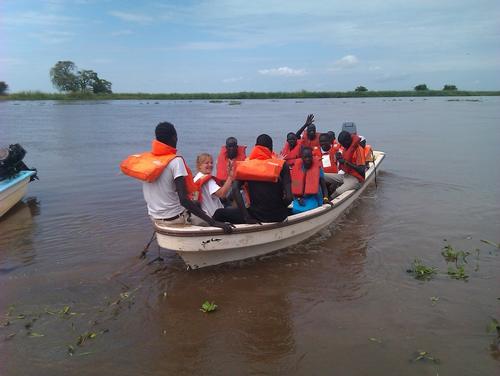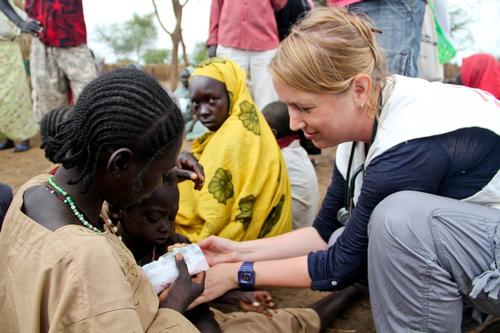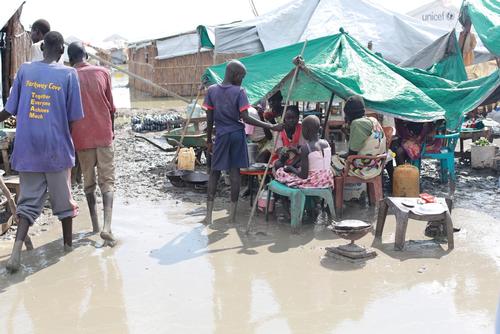More than one and a half million people are currently displaced from their homes in South Sudan after conflict swept through the world’s newest nation following a political crisis in December 2013. Many displaced families in remote areas have no access to health care and humanitarian relief is absent. In September, medical specialist Maartje Hoetjes flew by helicopter to one of South Sudan’s more remote areas to meet displaced families and assess their health status. She tells their stories here.
A helicopter drops me in a remote region in Upper Nile State, South Sudan. I’m here on an exploratory mission to find out what has happened to hundreds of families displaced from their homes in Nasir after ground fighting reached the town some months earlier. I meet with local authorities and traditional leaders who tell me, “People are hungry. We had to run, so we have nothing to plant. There is nothing else other than the milk of our cows and edible plants that we find. Children are dying and for the women, there is no assistance at birth.”
Local health workers tell me the same story: they see malnourished children, many patients with diarrhoea and pneumonia. They feel helpless, trying to work in dilapidated health posts with almost no medicine. In Mandeng, I walk through an empty market in the centre of the village and tell my translator that I’d like to speak to the affected families directly. We’re soon wading knee-deep through the swamp towards a group of mud huts where I see a woman waving to us.
Rose lived with her husband and children in Nasir but had to flee when heavy fighting reached the town. She’s grateful to the family that offered to share their hut with her. She is grateful for the cows and goats she managed to take with her as they provide milk for the children. She tells me “the cows are sick, we have lost seven in the past few weeks. But there are people who fled who have no cattle.”
She points to some green weeds in the swampy mud, “See that green there? We cook it in water.” I ask her where she gets the water from as the pumps in the village do not work properly. “The water comes out of the swamp - the children get sick, even grown men get sick, but it's all we have.”
In Jigmir, a small village on the Sobat river, I sit down with a group of fifteen women in the shadow of a ruined health clinic. Many of these women have fled their homes, all have had family members killed in the fighting, several are now widows. They start to talk about how the violence forced them from their homes. Stories filled with hate and death, their fears for the future.
A woman called Frances tells me, “We’re living in a muddy swamp. Every day we look for a place to spend the night. And when we finally find somewhere safe to sleep with the children, I can’t sleep. I lay awake thinking of all the others who have not survived ...”
Besides the constant concerns about safety, the women face a daily struggle to find enough clean water and food to feed their families. Their children often go hungry. The words of a young mother called Lucy break my heart: “When I think about all these problems, problems without solutions, sometimes I think it might be better to end things myself.”
It is quiet in the group. The woman sitting next to Lucy puts her arm around her. Another woman called Mary starts to talk about all the misery she has endured, but also about her faith and hope for the future. “No one can see into the future, only God knows what is coming our way. But we struggle through every day again and again. We are never alone.”
Two weeks later, I’m back to start a new project in the area. We set up a number of health posts and a mobile team travels along the Sobat river by boat from village to village in search of malnourished children who require admission into our therapeutic feeding programme. We repair the broken handpump.
In the village of Torkech, we set up our mobile clinic on the driest piece of land that we can find and meet the outreach workers we trained. They have pre-screened all children and pregnant women from surrounding villages for signs of malnutrition in the past few days and referred them here to us.
Just as we’re treating the first child, I see an elderly blind woman walking, supported by her grandchildren. Her back is hunched, her skin wrinkled, her arms and legs are like sticks, and two white spots in her eyes cloud her sight. I walk up to her and greet her.
I gesture to her grandchildren that I want to measure the circumference of her arm because she looks severely malnourished. I hold her hands gently and wrap the MUAC tape around her upper arm, seeing immediately that indeed she is severely malnourished. I offer her my arm, lead her to a chair and ask my colleagues to enrol her in our programme.
Once people see that the old woman has been enrolled, more elderly people are helped from huts and brought to us. Many are very thin, some also malnourished. I realize how often we overlook these older people, focusing on children while this group is so vulnerable.
As I hold her fragile hands, I wonder what this old woman must have seen and experienced in her long life. She searches for my hands, looking to shake them, “Shukran” (thank you) she whispers weakly.






